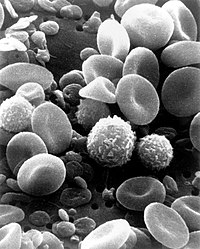
Photo from wikipedia
Abstract Background It has been suggested that eosinophils may be a prognostic marker of disease outcome in ulcerative colitis (UC), but conflicting data exist. The objective was to investigate the… Click to show full abstract
Abstract Background It has been suggested that eosinophils may be a prognostic marker of disease outcome in ulcerative colitis (UC), but conflicting data exist. The objective was to investigate the extent of mucosal eosinophils and peripheral blood eosinophil count in newly diagnosed UC patients and to investigate its predictive value in short- and long-term disease outcomes. Methods The degree of eosinophilia in baseline colonic biopsies and blood of newly diagnosed UC patients was retrospectively analyzed. It was investigated if tissue and blood eosinophilia could be a marker of a severe phenotype of UC, defined as the need for corticosteroids or immunomodulators in the first year or treatment with therapeutic monoclonal antibodies or colectomy during follow-up. Time to therapeutic monoclonal antibodies and time to colectomy were also evaluated as outcomes. Results There were 103 UC patients (median age 26 years) included. Median tissue peak eosinophil count (PEC) was 70.0 and median peripheral blood eosinophil count was 0.3 × 109/L at diagnosis. Tissue PEC (r = -0.161, P = .104) and blood eosinophil count (r = 0.022, P = .877) were not correlated with the severity of histologic inflammation. Logistic regression analyses did not identify PEC and blood eosinophil count as predictors of more severe disease outcomes. Tissue PEC and peripheral blood eosinophil count did not predict the time the initiation of therapeutic monoclonal antibodies or colectomy. Conclusion Baseline tissue or peripheral blood eosinophils are not markers of disease activity and cannot be used as a predictor of severe disease outcomes in both adults and children with UC.
Journal Title: Inflammatory Bowel Diseases
Year Published: 2022
Link to full text (if available)
Share on Social Media: Sign Up to like & get
recommendations!